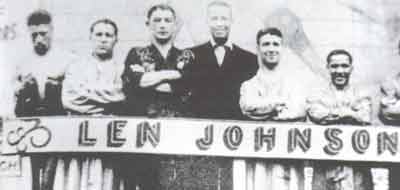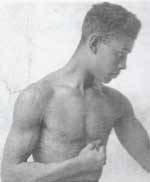|
Table of Contents
Rinsing off the Mouthpiece
By GorDoom
Current Champions, Top Contenders, and Fighters to
Watch Out For
By Adam Pollack
Hopkins-De La Hoya: A True Boxing Super Bowl
By Dean Vios
They Sure Don't Get Any Easier
By Orion Foote
The Best Argentinean Fighters of
All Time, Class by Class
By Martín Cameron
Hand Speed Among the Big
Fellows
By Don Cogswell
Flashback to the 2003 Hall of Fame
Inductions
Pictorial by Dan Hanley
Vince Martinez
By Dan Cuoco
Black Dynamite: Len Johnson
By Rob Howard
Wes Ramey
By Tracy Callis and Keith Palmer
Henry
Hank, One of Boxing's Forgotten Warriors
By Dan Cuoco
Joe Gans, the
Old Master
Joe Gans:
Championship Years
Two Articles By Monte Cox
|
BLACK DYNAMITE
LEN JOHNSON
(October 22nd 1902- September 28th
1974)
by Rob Howard
Click
for Len Johnson's Career Record
Born in Manchester, England, Len Johnson learned the noble art on the
boxing booths of Bert Hughes and ‘Professor’ Bill Moore, and eventually became
the owner of his own booth – travelling the roads and towns of England with
fairgrounds. Johnson developed into a highly skilled boxer, with an educated
left hand and a slippery defence that made him difficult to hit and left his
features largely unmarked throughout his career.
Managed by his father, Bill, Len embarked on a conventional boxing
career in 1921 that saw him win more often than he lost, but seemed to be headed
nowhere in particular. In the first three years, Johnson was regarded largely as a
journeyman performer whose real interest lay in his itinerant life on the
booths. Throughout his twelve-year ring career Johnson had a virtual ‘love
affair’ with the open-air life of the travelling boxing booth.
particular. In the first three years, Johnson was regarded largely as a
journeyman performer whose real interest lay in his itinerant life on the
booths. Throughout his twelve-year ring career Johnson had a virtual ‘love
affair’ with the open-air life of the travelling boxing booth.
Len Johnson’s boxing career took a dramatic turn in early 1925 when he
was matched with Roland Todd, the reigning British and former European
middleweight champion, in a non-title fight. Johnson took this opportunity very
seriously indeed, whilst Todd, somewhat jaded after returning from a campaign in
America, was below his best form. The result was a conclusive 20 rounds points
verdict for Johnson, and this had a considerable effect on re-aligning the
Manchester man’s fistic aspirations. From this point onwards, Johnson steadily
began to dominate the British middleweight division, with wins over Roland Todd
in a rematch, former World Welterweight Champion Ted ‘Kid’ Lewis (stopped in
nine rounds), Len Harvey, Gipsy Daniels, George West, Ted Moore, Jack Etienne,
Harry Crossley, Leon Jaccovacci, Michele Bonaglia, plus many other leading
British and European middle and light heavyweights of the period.
Unfortunately for Johnson, British boxing operated a rule known as the
‘colour bar’ in the 1920s (repealed in 1948) that prevented any coloured boxers
from fighting for championships. This rule had tacit support from politicians,
and had its origins in an irrational long-term fear felt by the ruling classes
of insurrection amongst the black colonial inhabitants of what was then the
British Empire. It was believed that black fighters defeating white fighters
would undermine the Empire, and incite rebellion. The consequence of this for
Johnson was that he could neither fight for championships nor persuade anyone
with political influence to effect a change in the status quo. Johnson lobbied
newspapers and politicians over a period of several years, only to meet with an
unchanging negative response and indifference to his situation.
Johnson spent the first half of 1926 in Australia, where he won the
British Empire middleweight championship by defeating local hero Harry Collins.
Johnson was popular and very successful in his six months Down Under, returning
home to get married. On arrival in England, Johnson discovered that his Empire
title – won fair and square against a formidable opponent – was not recognised
by the National Sporting Club, who controlled British boxing at that time. In
fact, the NSC had installed Scotland’s Tommy Milligan as British
 Empire champion –
openly snubbing the man now generally regarded by boxing fans everywhere as
Britain’s best middleweight, albeit unofficially. Johnson’s Empire title
victory, and two successful defences – all in Australia – only entered the
boxing record books many years later, due to the intransigence of officialdom. Empire champion –
openly snubbing the man now generally regarded by boxing fans everywhere as
Britain’s best middleweight, albeit unofficially. Johnson’s Empire title
victory, and two successful defences – all in Australia – only entered the
boxing record books many years later, due to the intransigence of officialdom.
In 1930 Johnson visited America on three occasions looking for fights,
on trips organised by New York promoter Jimmy Johnston, but proposed contests
did not materialise. In the same year, Johnson became the proprietor of his own
booth – realising a long-held ambition. From this point onwards, however,
eyesight problems and the onset of rheumatism caused a steady decline in
Johnson’s ring performances. In 1932 he lost a rematch with Len Harvey in a
contest that promoter Jeff Dickson billed as being for the British middleweight
championship, in defiance of the British Boxing Board of Control. The BBB of C
(formed in 1929) had taken over control of British professional boxing from the
NSC, but had retained the colour bar in its constitution. Later the same year,
1932, Johnson travelled to Paris where he was forced to retire after eight
rounds against the rugged Marcel Thil, then fighting at peak form. By the end
of 1933, Johnson had retired from boxing, concentrating thereafter on running
his travelling booth.
Shortly after war broke out in September 1939, Len Johnson sold his
boxing booth and dedicated the next few years to the war effort by joining the
Civil Defence. This marked the end of Johnson’s active involvement in boxing,
although he did, in the 1950s, write a boxing column for the Communist Party
newspaper, The Daily Worker. After the war, he joined the Communist
Party and also became active in trade union matters, causing himself to become a
thorn in the side of officialdom. Although Johnson failed six times to become
elected to Manchester City Council, he acted for many years as an unofficial
representative of the city’s black community – personally intervening in
disputes involving racism. Len Johnson is remembered by many today as a figure
who spent a lifetime in a personal battle against injustice and racism.
Anyone wanting to read about Len Johnson’s life and boxing career
should read Never Counted Out, written by Michael Herbert (1992).
Michael Herbert writes in detail about Johnson’s ring career and about the
origins of the racism that was endemic in British boxing prior to the Second
World War. Mr Herbert explores the flagrant injustices suffered by Johnson
during his boxing life, and also examines his subsequent involvement with the
Communist Party in the post-war years that was born out of his experiences.
Never Counted Out (published by Dropped Aitches Press, ISBN number
is 0-9519526-0-9) tells a story which present day generations may find hard to
believe actually happened – probably the most shameful episode in British
boxing’s long history. Essential reading for all boxing fans and social
historians.
Click for Len Johnson's Career Record |

